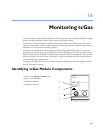
Manual Purging 15 Monitoring Airway Flow, Volume and Pressure
191
Adult Mode
The system automatically purges the sensor tubing every ten minutes or less, depending on system
conditions. In adult mode, the system will purge both sides of the line, one at a time, during each
purge cycle. The higher the pressure, the more frequent the purging. This action anticipates increased
moisture migration into the sensor tubing due to the increase in circuit pressure.
Neonatal and Pediatric Modes
The automatic purge cycles used in the neonatal or pediatric mode is fixed at every three minutes
regardless of circuit pressure. Only one side of the sensor tubing will be purged during each purge
cycle.
Unlike the adult purge mode, the neonatal or pediatric purge mode does not use the full force of the
internal pump, but rather pressurizes an internal reservoir which is used for the purge. This minimizes
the pressure delivered to the ventilator circuit, but does deliver a sufficient pressure to purge the sensor
tubing.
Manual Purging
Occasionally, purging may be required in between the automatic purge cycles. The manual purge may
be used as often as needed. Check the orientation of the flow sensor if repeated manual purge cycles
become necessary.
To manually purge, press the
Purge button on the module (marked by on international
versions of the module) or select
Purge in the Setup Spirometry window to initiate a combined
purge and zero cycle.
Gas Compensation
Temperature and the proportions of individual gases influence the flow measurement. If values seem
inaccurately high or low, check that the monitor is using the appropriate gas compensation. Gas
compensation can be done using either manually entered gas concentrations or gas concentrations
from the gas analyzer.
NOTE If you unintentionally switch the gas compensation to the incorrect setting, the accuracy of the
measured flow and volume values may be significantly reduced. The tables below show examples of
incorrect gas compensation settings and the resulting inaccuracies:
Table 1 Incorrect Balance Gas Setting (N
2
O instead of N
2
)
N
2
O
2
N
2
O Agent Difference between measured
and actual values
Actual Gas Composition
60 40
Gas Compensation Setting
40 60 15%


















